
Whether you are buying a collection of Russian art to decorate your home, or just interested to see what is out there, there’s lots to look out for at Russian Art Week 2014.
As valuable pieces descend on London’s auction houses, the week is a chance for everyone – buyers, auctioneers, art experts and casual browsers - to come face to face with long-lost masterpieces before the hammer comes down and the works disappear again into private collections and museums around the world.
RBTH picks out the stars of this autumn’s event.
1) Bakhchisarai, Boris Kustodiev, 1917
Lot 16, Sotheby’s

Source: Courtesy of Sotheby's
The pulsating colours, the life and theatrical subject matter of Kustodiev’s masterpiece, that captivate at a glance, mean this work demands little theoretical introduction. But the story is an unusual one.
Boris Mikhailovich Kustodiev (1878-1927) experienced a peak in his creative energies and output in the period around 1916-17, just as he started to deteriorate physically. Bakhchisarai is one of several important masterpieces painted at this time – in fact Kustodiev travelled to Bakhchisarai in 1915 when he was sent for a rest cure to Yalta, which turned out to be one of his last trips before he was virtually crippled by disease. As one critic mentioned ‘The irrepressible optimism of Kustodiev the artist increases in inverse proportion to the hopeless and tragic deterioration of Kustodiev the man’.
For collectors, the painting contains distilled characteristics of all Kustodiev’s best works; a sense of theatre, colour and excitement - a curtain raised on a bustling scene - coupled with a sumptuous, sensuous, exotic quality. The artist puts across a vision of Russia with a distinct, lively ethnicity – a country with at least half its soul in Eurasia. Here we have a luminescent palate, the smell of the smoke and spices of a Tartar marketplace.
Yet despite its positively glowing quality, this work has been hidden away for over 50 years. Kept in the same family for three generations, the painting was last exhibited in 1959. Until now, scholars only knew of Bakhchisarai from listings and inference, so the painting’s re-appearance is a major event for the art world.
2) Portrait of Aleksandr Tikhonov (1880-1956), Yuri Annenkov, 1922
Lot 38, Christie’s

Source: Courtesy of Christie’s
Encapsulating a time of seismic change, this portrait is one of the most important Russian paintings ever to go under the hammer in London. Selected to represent the USSR at the Venice Biennale in 1924, this particular masterpiece is a veritable celebrity of the art world, one of several portraits, which, to quote writer Yevgeny Zamyatin, serve as "a biography of a person and an epoch".
Besides being a renowned author, editor and literary figure, the subject, Aleksandr Tikhonov, was something of a social maven, co-founder of the famous Dom Iskusstv along with writer Maxim Gorky and poet, Korney Chukovsky. Other subjects who sat for Annenkov include poet, Anna Akhmatova, theatre director, Vsevolod Meyerhold and Bolshevik leaders, Leon Trotsky and Vladimir Lenin. All are portrayed with movement, eyes firmly fixed on the glorious future. As the painter himself said, ‘While some of my subjects impressed themselves on the bedrock of our era’s history and others are lost to anonymity, they are all without exception marked with one and the same symbol – that of Revolution. Each will act as living remembrances to me of those tragedies and hopes, falls and upsurges, according to which we were fated to march onwards together, side by side, friends and enemies alike…’
Tikhonov’s portrait is remarkable for the way it absorbs a number of jostling influences and styles prominent at the time – with elements of Russian folk-art, Cubo-Futurism, Primitivism and Expressionism, sculpture and artistic experiment all seamlessly synthesised into a harmonious whole.
3) Portrait of Maria Zetlin (1882–1976), 1910, Valentin Serov
Lot 15, Christie’s

Source: Christie's
In the century since it was painted, Serov’s portrait of Maria Zetlin has been exhibited all over the world, from Rome, to Malmö to Tel Aviv. This year’s Russian Art Week will be the first time in history that the renowned work is up for sale.
Painted in 1910, after the first revolution of 1905, when tensions were stirring in advanced of the final upheaval of 1917, Serov’s work depicts the poignant final act in the story of the Russian aristocracy; an ephemeral community of ideas and beauty, a society on the cusp, about to disappear forever. Fittingly, Maria Zetlin’s portrait has a haunting, transient quality, a sense of movement and a lost moment captured in the subtlest of tones and colours – Maria is about to turn away from the window and walk quietly out of the frame.
In the early 1900s Serov was the most celebrated Russian portrait painter alive, the artist of choice for Nicholas II and the cream of Russian society, commanding the princely sum of 5,000 roubles for each commission. But when Serov first set eyes on the young, bright and beautiful Maria Tumarkina in a Parisian restaurant, it was the artist who approached the subject, adamant that she should sit for him. Four months later, Maria married Mikhail Osipovich Zetlin, and invited the artist to Les Moettes, their villa in Biarritz, to paint her portrait.
The portrait depicts one half of a couple at the very centre of Parisian intellectual life, whose flat on Avenue Henri-Martin was frequented by Diego Rivera, Pablo Picasso and Georges Braque. Maria became the preferred sitter for many artists and the Zetlins went on to amass a significant collection of Russian art.
All rights reserved by Rossiyskaya Gazeta.
Subscribe
to our newsletter!
Get the week's best stories straight to your inbox